Romford, Essex
Up to 1834
Romford (or "Rumford") was the subject of a report in An Account of Several Workhouses..., dated October 24th, 1724.
I must, SIR, observe to you, that the Advantage of the Workhouse to the Parish, does not arise from what the poor People can do towards their Subsistance, but from the Apprehensions the Poor have of it. These prompt them to exert, and do their utmost to keep themselves off the Parish, and render them exceedingly averse to submit to come into the House, till extream Necessity compels them.
PRIDE, tho' it does ill become poor Folks, won't suffer some to wear the Badge; others cannot brook Confinement; and a third Sort deem the Workhouse to be a mere State of Slavery, and so Numbers are kept out.
THERE are two things more that have greatly contributed to render the Workhouse beneficial towards reducing the Poor's Rate, viz. That whereas before a great many Pensions were granted, thro' Partiality or Favour, these are all stopped: An whereas it was usual to pay Rents for the Poor, we have resolved to pay none ; and in this Article we have saved to the Parish above 70l per Annum.
BEFORE opening of the House, our Poor were sometimes 1s. 8d. and 1s. 10d. and never under 1s. 6d. per Pound ; last Year they were but 1s. out of which too we paid a Debt of 50l. and this Year we hope to some off for 8d.
THE Expenses for the Workhouse from Michaelmas 1723, to Michaelmas 1724, were 147l. 11s. 0d ¼, and the Receipts for the Labour and Work of the poor in the same Time, were 10l. 17s. 7d. ¼.
The Orders in the Work-house at Rumford are to the following Effect.
I. THAT the Master and Mistress be sober and orderly Persons, and not given to swear, and that they see the Orders strictly performed.II. THAT they rise by seven a Clock in the Morning from Michaelmas to Lady-Day; and by six from Lady-Day to Michaelmas.
III. THAT they see the Family a Bed by eight a Clock, and their Candles out, during the Winter half-Year ; but in the Summer half-Year, that they be in Bed by nine.
IV. THAT they have their Breakfast in the Winter half-Year at eight in the Morning, and in the Summer half-Year by seven.
V. THAT they have their Dinner by one a Clock all the Year.
VI. THAT they have their Supper at six in the Evening during the Winter half-year, and in the Summer at seven.
VII. THAT the Beer be drawn by one Person for a whole Day in his Turn.
VIII. THAT the Cloth be laid by Turns for Breakfast, Dinner, and Supper.
IX. THAT they sit at the Table to eat their Meals in a decent manner.
X. THAT the Master say Grace before, and after their Meals.
XI. THAT they have the House swept from top to bottom every Morning, and washed once a Week.
XII. THAT they are called to work in Summer by seven, and in the Winter at eight in the Morning.
XIII. THAT they leave Work at seven a Clock at Night in the Summer, and six in the Winter.
XIV. THAT no Person go out of the Gate without the Master's Leave.
XV. THAT if any Person steals, or is heard to swear, or curse, for such Crimes the first time to stand on a Stool at one Corner of the Working-Room, the whole Day, with the Crime pinned to their Breast.
XVI. THAT for the second Offence, he or she stand in the like Posture, and have half a Pound of Bread, and a Quart of Water for that Day.
XV1I. THAT for the third Offence, he or she be ordered by a Justice of Peace to be publickly whipt.
XVIIL THAT the Master read, or cause to be read, Prayers every Morning before Breakfast, and every Evening before Supper, and call together as many as can be conveniently there.
XlX. THAT these Prayers shall be out of the Whole Duty of Man, or some other good Book, as the Minister shall appoint.
XX. THAT the Master and Mistress shall every Lord's Day attend at the Publick Worship, with as many of the House as are not hindred by a just Reason.
XXI. THAT on the Lord's Day, either before Church, or after Dinner, he do read, or cause to be read, the Psalms and Lessons appointed for the Morning Service : and after Evening Prayer, the Psalms and Lessons for the Evening Service ; and also a Section or Chapter out of the Whole Duty of Man.
XXII. THAT the Master and Mistress do receive the Holy Sacrament four Times every Year at least.
XXIII. THAT the Master do give an Account every Monthly Meeting, of all such as are negligent and disorderly.
The location of the workhouse is uncertain but may have been near the Market Place. Romford erected a new workhouse in 1787 in a field called Joy's Mead, at the west side of North Street, Romford, to the north of the Roger Reede almshouses. It could house up to 250 inmates. In 1832, the had 121 in residence (38 Men, 32 Women, 30 Boys, and 21 Girls) and was said to be "very well regulated". Bread was also baked there and delivered to the parish's outdoor poor instead of giving them relief in money. After the opening of the new union workhouse in 1839, the building was sold off and then demolished.
In a report dated 13 March, 1725, parish workhouse was in operation at Barking (alias Bury-king):
The Number of Poor now in the House is,
| 4 old Men | } from 50 to 80 Years of Age. |
| 10 old Women | |
| 3 Boys | } from 4 to 7 Years of Age. |
| 3 Girls |
THEIR Employment is picking Ockam, at which they earn altogether about 20l. per Annum ; the Materials for this Sort of Work being pieces of old cable, or Junk (as it is called), are bought of two Merchants, one at Rotherhith, near Three Mariners Stairs, and the other at Cuckold's Point, and cost 7s. per hundred Weight ; which is sold again in Ockam for 10s. per Hundred.
Or in spun Yarn at 2d. ½ per pound.
Or in Rope Yarn at 2d. per pound, or 16s. 8d. per C. Wt. For all these are made out of old Cable.
THE Women knit, and mend Stockings for the whole Family, make Beds, and keep the House clean, and sometimes pick Ockam.
The Steward and his Wife have the Government of the Family ; he buys all the Necessaries for Food at the Market, and she takes Care for dressing it.
The Victuals is divided into Messes, 4 Persons to a Mess ; this being a cheap Country for Flesh, they have 4 Flesh Days in the Week, according to the following Bill of Fare, viz.
| Breakfast. | Dinner. | Supper. | |
| Sunday | Sheeps Head Broth | Beef, Pudding, and Broth | What's left at Noon |
| Monday | Beef Broth | Oatmeal Hasty Pudding with a quarter of a Pound of Butter to a Mess | Bread Butter or Cheese |
| Tuesday | Hasty Pudding | Three bak'd Ox Cheeks | What's left at Dinner |
| Wednesday | Ox Cheek Broth | Pease Porridge | Bread, Cheese and Butter |
| Thursday | Hot Pease Porridge | Beef & Broth | What's left at Dinner |
| Friday | Beef Broth | Milk Porridge | Bread and Cheese |
| Saturday | Milk Porridge | Sheep's Head for each Mess | What's left at Dinner |
Bread and Beer are allowed without Limitation.
They have Roast Beef at the Three Great Festivals, and Plumb-Pudding at Christmas.
The Poor's Rate here is reduced from 2s. to 1s. in the Pound, and the Poor better provided for.
The Barking workhouse was located on North Street and in 1777 could house up to 70 inmates. The parish erected a new workhouse in 1788, near the Bull Inn on North Street. The brick building was two storeys high, plus a basement, with two side wings, and cost of £4,000. An inscription above the front entrance read 'This House of Industry at the sole Expence of the Inhabitants of Barking is to provide and protect the Industrious and to punish the Idle and Wicked'.
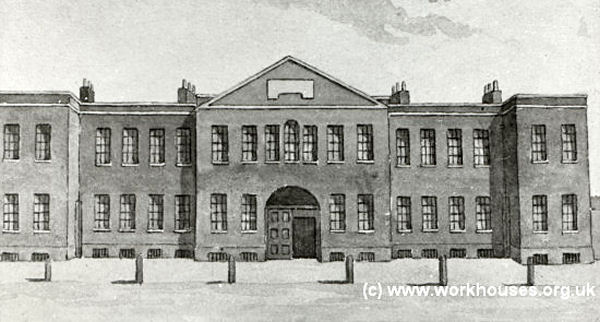
Former North Street workhouse, Barking, late 19th century.
© Peter Higginbotham.
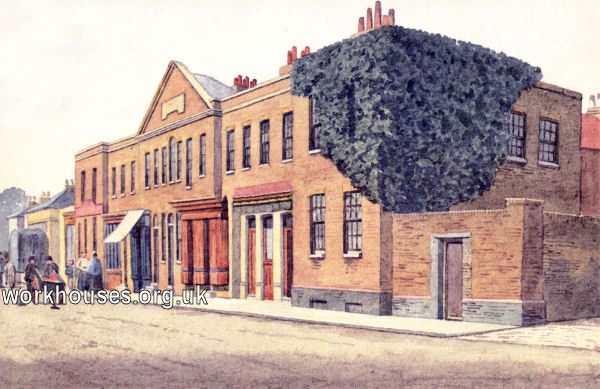
Former North Street workhouse, Barking, c.1905.
Hornchurch established a workhouse in 1721 in four cottages, previously part of Pennants almshouses, at the corner of Billet Lane and the High Street. A supermarket now occupies the site.
Dagenham had a workhouse in the 1730s-40s in a property known as Wright's on Church Elm Lane, formerly used as almshouses. In 1777, it could house 30 inmates. After the formation of the Romford Union in 1836, it the building returned to use as almshouses.
A parish workhouse operated at Upminster in a building on St Mary's Lane dating from around 1751. In 1777, could hold up to 20 inmates. The property was subsequently converted to a row of cottages.
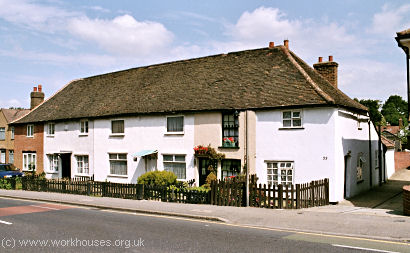
Upminster former parish workhouse, 2004.
© Peter Higginbotham.
After 1834
Romford Poor Law Union formally came into being on 31st May, 1836. Its operation was overseen by an elected Board of Guardians, 24 in number, representing its 10 constituent parishes as listed below (figures in brackets indicate numbers of Guardians if more than one):
Essex: Barking (8), Cranham, Dagenham (2), Hornchurch (3), Havering-atte-Bower, Rainham, Romford (5), Upminster, Great Warley and Wennington.
The population falling within the Union at the 1831 census had been 19,521 with parishes ranging in size from Wennington (population 127) to Barking (8,036) and Romford itself (4,294). The average annual poor-rate expenditure for the period 1833-5 had been £11,958 or 12s.3d. per head.
Initially, the union took over the existing parish workhouses at Romford and Barking. A new union workhouse was erected in 1838-39 on a five-acre site on Oldchurch Road to the south-west of the town. The site, then open farmland, was bought from a Mr Philpot at £160 per acre. Originally, three architects (James Savage, Sampson Kempthorne and Francis Edwards) submitted plans and tenders for the new building which was to accommodate 450 inmates. Savage later withdrew, and the nine-man building committee eventually chose the plans of Francis Edwards by a vote of five to four.
Edwards' design, although based on the popular cruciform plan, was unusual in having the main accommodation ranges running diagonally rather than square to the outer perimeter walls. Among the relatively few other examples of this type of layout are George Wilkinson's Oxfordshire workhouses at Chipping Norton and Witney. No other workhouse buildings are attributed to Francis Edwards.
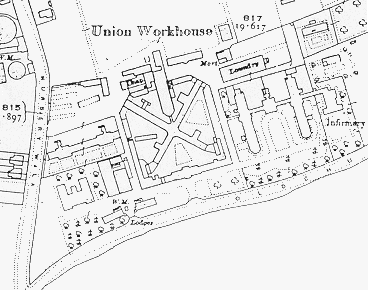
Romford workhouse site, 1890
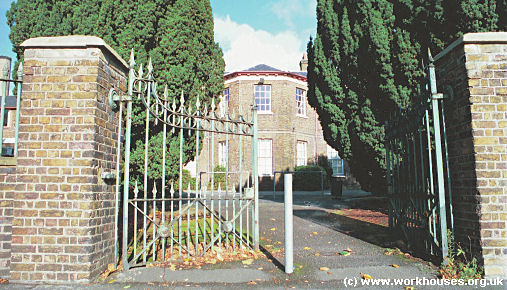
Romford entrance from the south, 2000.
© Peter Higginbotham.
The entrance block to the south would have contained the Guardians' Board Room and other administrative offices.
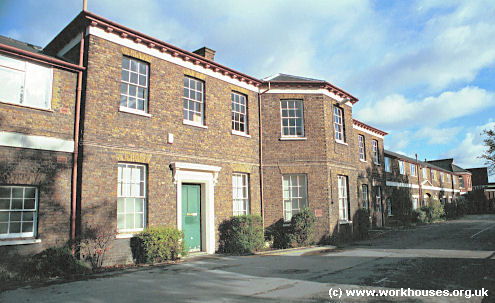
Romford entrance block from the south-west, 2000.
© Peter Higginbotham.
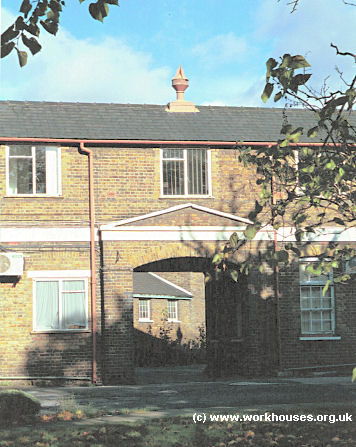
Romford entrance archway, 2000.
© Peter Higginbotham.
The main accommodation ranges radiated from a central octagonal hub which incorporated observation windows for the workhouse master to observe each of the four inmates yards.
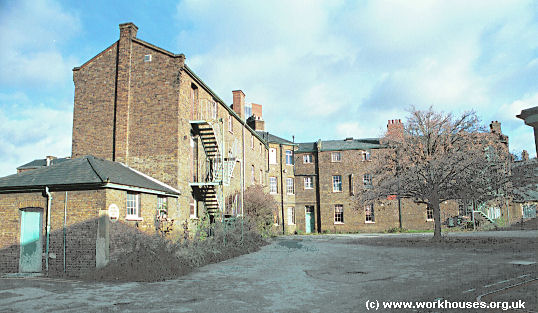
Romford south-east and south-west ranges from the south-west, 2000.
© Peter Higginbotham.
The north-east and south-east ranges contained the females' day rooms and wards. Those to the north-west and south-west provided male accommodation. Dining-rooms and kitchens lay at the north of the building.
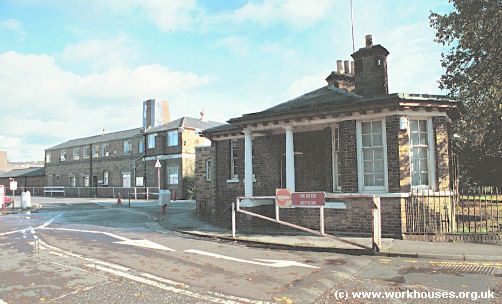
Romford entrance lodge, 2000.
© Peter Higginbotham.
According to an 1840s directory, able-bodied paupers at the workhouse were employed in grinding corn and cultivating the garden ground, etc.
By the 1890s, a pavilion-plan infirmary had been erected at the east of the workhouse. It comprised a staff block with male and female pavilions placed at either side, and a further block at the east, perhaps housing offices or nurses' accommodation.
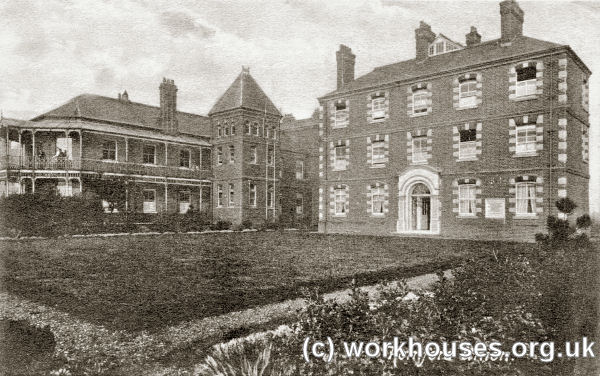
Romford workhouse infirmary from the south-east, early 1900s.
© Peter Higginbotham.
In 1922, during a period of high unemployment, two thousand men marched to the workhouse to lobby a meeting of the Romford Board of Guardians. The demonstrators were petitioning for an increase in their unemployment pay, which was less than that given to those living within adjacent districts falling within the Greater London boundary. Although a few of the Guardians sympathised with the request, the majority refused to give the men a hearing, or even a ration of bread and cheese. Instead the Board adjourned for their own lunch, ordering the workhouse gates to be locked. During the afternoon, when the gates were opened to allow a vehicle to leave, the men rushed through. They helped themselves to loaves from the bakehouse, and towels and blankets were stolen from the infirmary. Refusing demands from the Guardians that to leave, the men barricaded the Guardians inside the workhouse. Two Guardians tried to drive their cars through the crowd, but their vehicles were damaged. Later in the evening, the Chief Constable of Essex arrived at the scene and advised the Board that giving the men a hearing would be a far quicker way of resolving the situation than organizing a sufficient body of police reinforcements. The Guardians reluctantly agreed and, surprisingly, were moved by the case put by the men. Action was promised and was followed up by the efforts to change official rules and provide more money to support the unemployed.
The former workhouse buildings later became part of Oldchurch Hospital. The cruciform section of the workhouse was demolished in 2000 to make way for a car park.
Children's Homes
In 1905, the Romford Guardians decided to adopt the scattered homes system for its pauper children. Two large semi-detached houses were purchased for use as a receiving and probationary home. Initially, thirty children were housed there under the care of a foster mother and one assistant. On 24th September, 1907, Gertrude Smedley was appointed foster mother of the scattered homes at 3, Adelaide Villas, Mawneys, Romford — aged only 19 years she was the youngest ever foster mother employed by the union.. By 1914, there were children's Homes at 5-8 Laurie Square, and 1-2 the Croft, Heath Park Road. In 1914, there were scattered homes operating at Gilmore House, 36 Pelham Road, and Richmond House, 38 Pelham Road, Ilford. In 1929, there were homes at 26-28 Manor Road, 42-44 Brentwood Road, and on King Edward Road.
Staff
- 1846 — Clerk to the Board of Guardians: WH Clifton; Relieving officers: John B Miller and Richard Parker; Chaplain: Rev. Thomas Donkin; Master and Matron of workhouse: Mr. T. and Mrs. Sellars; Miller: Charles Godbold; Schoolmaster: Walter Easton; Schoolmistress: Martha Howman; Porter: William Hawes. Eight surgeons were employed by the Union.
- 1881 Census
Inmates
Records
Note: many repositories impose a closure period of up to 100 years for records identifying individuals. Before travelling a long distance, always check that the records you want to consult will be available.
- Essex Record Office, Wharf Road Chelmsford CM2 6YT. Relatively few records survive. Holdings include: Guardians' minute books (1836-1930); etc.
Bibliography
- Higginbotham, Peter The Workhouse Encyclopedia (2014, The History Press)
Links
- None.
Unless otherwise indicated, this page () is copyright Peter Higginbotham. Contents may not be reproduced without permission.


